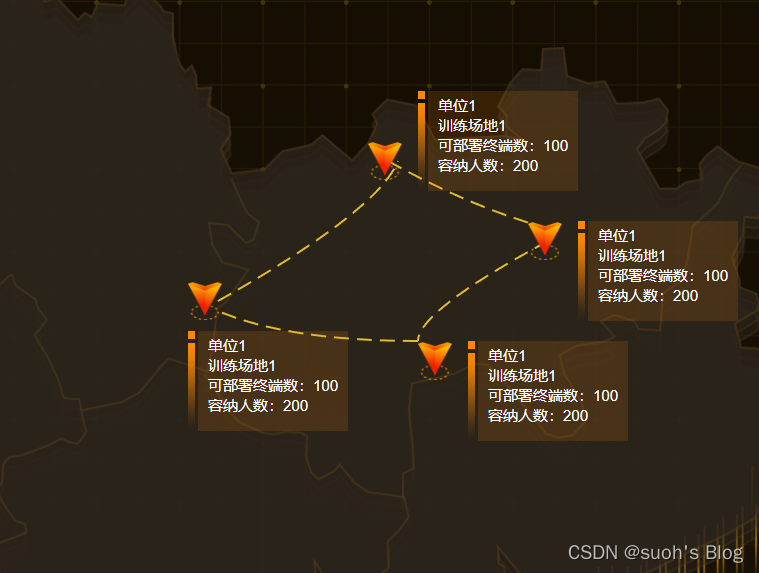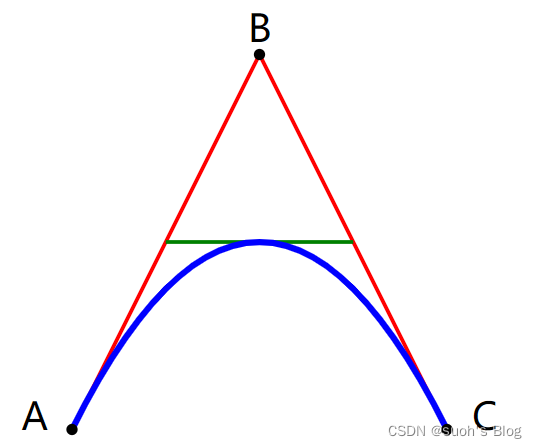效果图:

?html
<svg class="svgClass" xmlns="http://www.w3.org/2000/svg" version="1.1" width="1100px" height="700px">
<!-- 标记点之间的路径 -->
<path v-for="(item,i) in paths" :d="item.path_d" fill="none" stroke-width="2" stroke-dasharray="15 8" stroke="blue" style="fill:none;stroke:#E3BA2D;stroke-width:2;stroke-linejoin:round"></path>
<!-- 标记点图片展示 -->
<image v-for="(item,i) in pointers" style="cursor:pointer" xlink:href="../../assets/img/jichu/point.png" type="image/jpeg" :x="item.x" :y="item.y" width="34" height="40" />
<!-- 标记点详情背景展示 -->
<image v-for="(item,i) in infos" style="cursor:pointer;" xlink:href="../../assets/img/jichu/borderbg.png" type="image/jpeg" :x="item.x" :y="item.y" width="200" height="100" />
<!-- 详情内容展示 -->
<text v-for="(item,i) in infoDw" :key="i" class="textsvg" :x="item.x1" :y="item.y1">{{item.dw}}</text>
<text v-for="(item,i) in infoDw" :key="i" class="textsvg" :x="item.x2" :y="item.y2">{{item.train}}</text>
<text v-for="(item,i) in infoDw" :key="i" class="textsvg" :x="item.x3" :y="item.y3">可部署终端数:{{item.zdNum}}</text>
<text v-for="(item,i) in infoDw" :key="i" class="textsvg" :x="item.x4" :y="item.y4">容纳人数:{{item.person}}</text>
</svg>data中定义的变量
/** svg中所有标记点坐标 */
pointers: [
{ x: 700, y: 180 },
{ x: 520, y: 320 },
{ x: 860, y: 260 },
{ x: 750, y: 380 },
],
/** svg中所有路径数组 */
paths: [
{ path_d: "M720,200 Q810,250,890,270" },//顺时针路径1
{ path_d: "M880,280 Q750,350,750,380" },//顺时针路径2
{ path_d: "M750,380 Q620,380,550,350" },//顺时针路径3
{ path_d: "M550,340 Q710,250,730,200" },//顺时针路径4
],
/** 所有悬浮框坐标 */
infos: [
{ x: 730, y: 130, show: true },
{ x: 500, y: 370, show: true },
{ x: 890, y: 260, show: true },
{ x: 780, y: 380, show: true },
],
/** 所有悬浮框详情内容展示 */
infoDw: [],【注意】【注意】【注意】
在data中我定义了svg的path路径变量例如:?path_d: "M720,200 Q810,250,890,270" ,它代表的含义是:M后面的两个坐标是起点的xy值(下图A点),Q代表的是路径的控制点(也就是路径的曲度偏向,下图B点),最后两个坐标是重点的xy值(下图C点)
A 和 C 分别是起点和终点,B 是控制点?
 ?
?
?
data中的坐标定义见下图:?

由于悬浮框的信息坐标有规律可循,因此我写了一个方法去循环获取坐标,可以节省代码空间?
methods中获取悬浮框text标签的坐标,在mounted中调用即可:
getDetailxy() {
//悬浮框内容的坐标跟悬浮框的坐标基本一致
//通过循环悬浮框的数组来给框内的详情坐标进行赋值
this.infos.map((item, i) => {
let x = item.x + 40
let y = item.y
this.infoDw.push(
{
dw: '单位1', train: '训练场地1', zdNum: 100, person: 200,
show:true,
x1: x, y1: y + 20,
x2: x, y2: y + 40,
x3: x, y3: y + 60,
x4: x, y4: y + 80,
}
)
})
},注意:svg中不能使用html标签,例如div,img等,因此在svg中一般使用image标签放置图片,text图片放置文本内容。